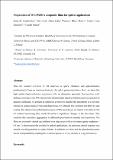Files in this item
Preparation of WS2-PMMA composite films for optical applications
Item metadata
| dc.contributor.author | Szydłowska, Beata M. | |
| dc.contributor.author | Graf, Arko | |
| dc.contributor.author | Kelly, Adam | |
| dc.contributor.author | Blau, Werner J. | |
| dc.contributor.author | Gather, Malte C. | |
| dc.contributor.author | Zaumseil, Jana | |
| dc.contributor.author | Backes, Claudia | |
| dc.date.accessioned | 2021-03-06T00:38:41Z | |
| dc.date.available | 2021-03-06T00:38:41Z | |
| dc.date.issued | 2020-08-21 | |
| dc.identifier | 269924209 | |
| dc.identifier | 33e6c237-f6f9-4968-946c-0e1017a46f1a | |
| dc.identifier | 85089806661 | |
| dc.identifier | 000560902700019 | |
| dc.identifier.citation | Szydłowska , B M , Graf , A , Kelly , A , Blau , W J , Gather , M C , Zaumseil , J & Backes , C 2020 , ' Preparation of WS 2 -PMMA composite films for optical applications ' , Journal of Materials Chemistry C , vol. 8 , no. 31 , pp. 10805-10815 . https://doi.org/10.1039/c9tc06783c | en |
| dc.identifier.issn | 2050-7534 | |
| dc.identifier.other | ORCID: /0000-0002-4857-5562/work/79918129 | |
| dc.identifier.uri | https://hdl.handle.net/10023/21565 | |
| dc.description | C. B. acknowledges the German research foundation DFG under Emmy-Noether grant BA4856/2-1. C. B., J. Z. and M. C. G. acknowledge the Volkswagen foundation under grant agreement no. 93404-93406. W. J. B. gratefully acknowledges support by a research grant from Science Foundation Ireland (SFI) under Grant Number 12/IA/1306. | en |
| dc.description.abstract | Thus far, research activities of 2D materials in optics, photonics and optoelectronics predominantly focus on micromechanically cleaved or grown nanosheets. Here, we show that high quality liquid-exfoliated nanosheets offer an alternative approach. Starting from well-defined, monolayer rich WS2 dispersions obtained after liquid exfoliation and size selection in aqueous surfactant, we present an optimised protocol facilitating transfer of the nanosheets to a polymer solution in organic media. From such dispersions, we fabricate WS2–polymer thin films by spin coating. The characteristic photoluminescence of WS2 monolayers is retained in the film at 2.04 eV without broadening (line width 40 meV) or significant changes in the line-shape. This confirms that nanosheet aggregation is efficiently prevented on transfer and deposition. The films are extremely smooth and uniform over large areas with a root mean square roughness <0.5 nm. To demonstrate the potential in optical applications, the nonlinear optical response was studied, revealing promise as optical limiter. In addition, we show that the photoluminescence can be manipulated by coupling the exciton response to cavity photons in a Ag microcavity. | |
| dc.format.extent | 11 | |
| dc.format.extent | 981777 | |
| dc.language.iso | eng | |
| dc.relation.ispartof | Journal of Materials Chemistry C | en |
| dc.subject | QD Chemistry | en |
| dc.subject | Chemistry(all) | en |
| dc.subject | Materials Chemistry | en |
| dc.subject | NDAS | en |
| dc.subject.lcc | QD | en |
| dc.title | Preparation of WS2-PMMA composite films for optical applications | en |
| dc.type | Journal article | en |
| dc.contributor.institution | University of St Andrews. School of Physics and Astronomy | en |
| dc.contributor.institution | University of St Andrews. Sir James Mackenzie Institute for Early Diagnosis | en |
| dc.contributor.institution | University of St Andrews. Centre for Biophotonics | en |
| dc.contributor.institution | University of St Andrews. Biomedical Sciences Research Complex | en |
| dc.identifier.doi | 10.1039/c9tc06783c | |
| dc.description.status | Peer reviewed | en |
| dc.date.embargoedUntil | 2021-03-06 |
This item appears in the following Collection(s)
Items in the St Andrews Research Repository are protected by copyright, with all rights reserved, unless otherwise indicated.

